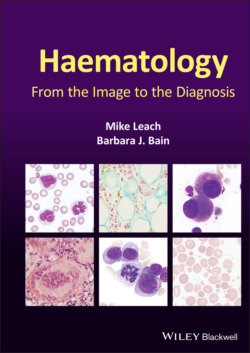Читать книгу Haematology - Barbara J. Bain, Irene Roberts - Страница 34
Оглавление25 Reactive lymphocytosis due to viral infection
An 18‐year‐old ‘fresher’ medical student was referred to the university medical service with a fever, sore throat and cervical lymphadenopathy. His full blood count showed Hb 144 g/l, WBC 74 × 109/l, neutrophils 7.4 × 109/l, lymphocytes 66 × 109/l and platelets 203 × 109/l. The liver enzyme profile showed increased transaminases (AST 300 u/l, ALT 279 u/l) and a Monospot® test (which later became available) was positive. Epstein–Barr virus (EBV) was subsequently detected in his blood at 5606 copies/ml. The blood film caused some initial concern amongst the trainees due to the magnitude of lymphocytosis, but further careful morphological review from more senior members of the department was reassuring. Notably, the blood film shows a population of medium to large pleomorphic lymphocytes (all images ×100 objective), with some showing fine cytoplasmic granules. The cells have voluminous cytoplasm and tend to be indented by adjacent red cells (top images). Importantly, some cells have blastoid morphology, being larger with a prominent nucleolus and having more pronounced cytoplasmic basophilia. Flow cytometry identified a large population of CD8+, CD5+, CD2+, HLA‐DR+, CD7+/− cells which were not expressing precursor antigens, CD30 or CD25. The morphological diagnosis is a reactive lymphocytosis due to viral infection, in this case EBV infection. The flow cytometric studies are in keeping with this as expression of HLA‐DR is an activation marker of T cells and such cells frequently show some loss of CD7 expression. The activated cells are cytotoxic CD8+ T lymphocytes even though EBV targets the B‐lymphoid population.
Reactive lymphocytosis is relatively common in clinical practice and the morphological features described above are typical. Neoplastic disorders tend to have more monomorphic appearances, but of course a careful assessment of the clinical circumstances is always necessary. T‐cell neoplasms are remarkably variable in their presentation but the clinical history, morphology, laboratory investigations and flow cytometric findings were all consistent with a reactive process. Importantly, a wide range of viruses and other organisms can induce such a reaction; these include EBV, cytomegalovirus, human immunodeficiency virus (HIV), toxoplasma and pertussis. Most often the responsible organism is benign but if HIV is implicated it is important that this is identified. A positive test for a heterophile antibody is a pointer to EBV infection but not all cases are positive. Immunophenotyping is not generally indicated but was performed in this case because of initial concern about the possibility of a lymphoma.
MCQ
1 Infectious mononucleosis due to the Epstein–Barr virus:Can be associated with pure red cell aplasiaCan be complicated by haemophagocytic lymphohistiocytosisCan be followed by aplastic anaemiaIs associated with a subsequent increased incidence of Hodgkin lymphomaPredisposes to B‐lineage acute lymphoblastic leukaemiaFor answers and discussion, see page 206.
